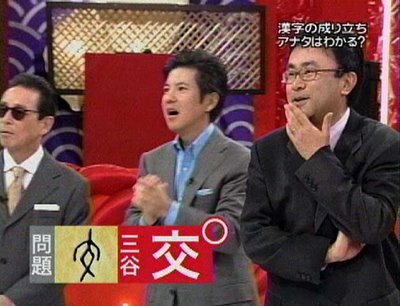Japonica Logos: Kanji; Answers
These are the answers for the questions on the "kanji origins" edition of "Japonica Logos."
Question 1: The kanji for dove/pigeon: 鳩「はと」is comprised of 九 and 鳥 because the "on" or Chinese reading of 九 (9) is "ku"... which basically reflects the sound the dove/pigeon makes. See the pic below:

Question 2: The kanji formed from the image of two people (the second one upside down) form the kanji 化 (か、け、化ける「ばける」), which means "to change," basically. The second person is upside down, like in death... it's kind of like life and death. I believe for Tarot cards as well, the major trump card "Death" represents change.

Question 3: The image turned into the kanji meaning "to mix": 交 (こう、まざる、まじる、etc.). The image is like how we put our hands to our knees, join the knees together, switch hands on the knees, bend the knees outward, join the knees again, switch hands on the knees again, etc.

Question 4: This one was tough, but let's look at the concept again: a man in ancient China of 3000 years ago is walking through an untraversed plain, holding a head in his hands: the head represents tax or tribute from an enemy village; he walks through an untravelled before plain... in other words, he's creating a path or road, and thus forms the kanji 道 (どう、みち: road).

Hope you had fun guessing!

0 Comments:
Post a Comment
<< Home